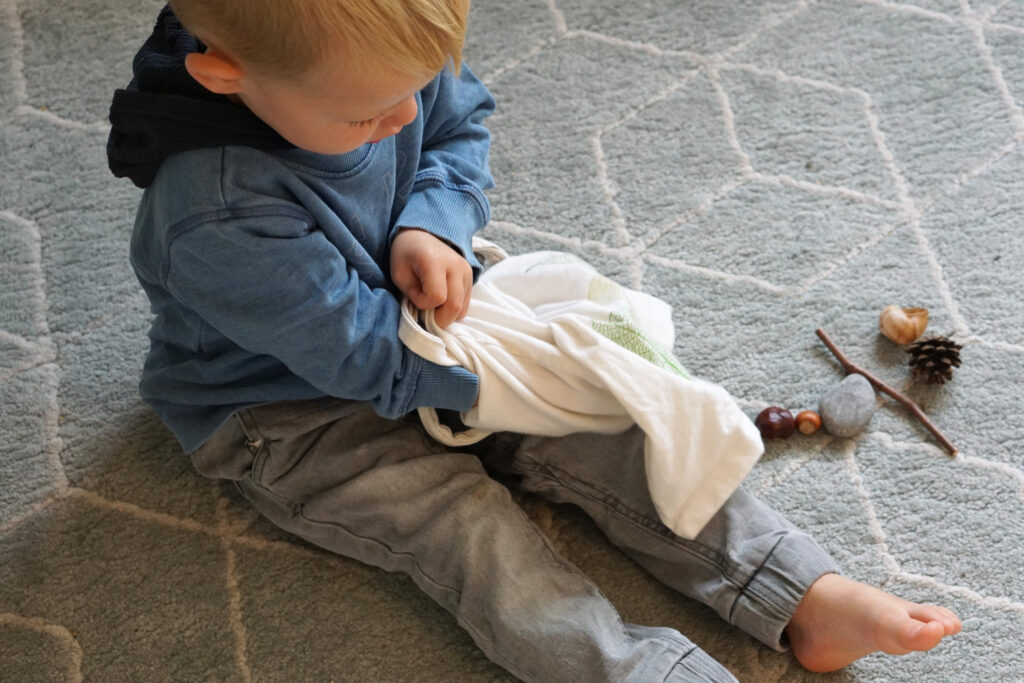
As the weather starts to cool we also discover the first acorns, beechnuts, and conkers during our walks in the forest and neighbourhood. These are perfect items for an autumn stereognostic bag.
In short, this Montessori activity involves the child trying to identify items in a cloth bag without being able to see them. This skill relies on something called stereognosis.
Stereognosis is the ability to identify objects without looking at them. For example, stereognosis is required to find your keys in the bottom of a bag or to do up a button without looking at it. Children will rely on stereognosis to become more efficient at dressing themselves as they learn to do up zippers and buttons or find armholes without needing to see everything that their hands are doing.
I love this quote from Maria Montessori in The Discovery of Childhood:
They are proud of seeing without eyes; they shout, holding out their hands: “Here are my eyes, I see with my hands, I do not need eyes.” And I always reply to these gay cries: “Ah, well! let us all get rid of our eyes; what more shall we do? ” And they break out into laughter and cheers.
Truly our little ones, walking in ways beyond our vision, make us wonder at their unforeseen, unexpected progress; and, whilst they seem sometimes to be little creatures mad with joy, we are left in profound meditation.”
From experience, I have always found it difficult to introduce stereognostic bags to toddlers because they find it so hard not to look in the bag. With Oliver, the process of naming the item before pulling it out of the bag only clicked well after three.
These photos are from the first time I presented the activity to Henry. He was two years old at the time. He was familiar with all of the items in the bag as we had used most of them in a sorting activity already. He was also able to name each of the items, so this activity was a great way to reinforce his new vocabulary.


Presentation
This is the procedure I learnt in my training. I sat together with Henry on the mat and demonstrated putting my hand into the cloth bag without looking in. I exaggerated my body language to show that I was really concentrating and said “I’m touching an… acorn” then slowly pulled out the item to check “Yes, it’s an acorn!”
Then it was Henry’s turn. He stuck his hand in and pulled something out straight away. “Oh, you found a pinecone,” I said, “pinecone” he copied. We followed this process until he had pulled out and named each of the items. He seemed genuinely intrigued each time he was able to see the item he had been holding in his hand.
I tried a different approach. I put the items back and asked “can you find the snail shell?” He pulled one item out followed by the next, seemingly by trial and error, until he found the shell and excitedly presented it to me.
Although Henry wasn’t able to identify the objects without looking at them at the time, he seemed to really enjoy the activity. It is something we return to every now and again as you never know when the interest will develop. For Oliver, it was at about four years old when he really showed interest and then it became one of his favourite activities for a while. He particularly enjoyed taking turns selecting items to put in the bag for the other person.
To weave in new and varied vocabulary I also like to describe each item before naming it, something along the lines of “I’m touching something rough/smooth/hard, etc”.
Making it easier
- One way to make the activity easier is to have two of each item in the bag. First, the child takes out an item and then the adult tries to find the matching item. When the child is ready the adult can go first.
Notes on Materials
- The bag in the photos is made from an old fabric shopping bag. I made it a little smaller by sewing and trimming about 10 centimetres off the bottom. I have used the Nienhuis bags before and like how they have openings on each side to slip the hands in so I sewed part of the opening closed leaving a hole at each end for the hands. I found this makes it much harder for a toddler to peak in but it is a bit more fiddly for them to use than a drawstring bag.
Safety
The types of objects you choose will depend on the age and developmental stage of the child. When children are mouthing objects or when appropriate supervision cannot be provided, select larger objects that do not pose a choking hazard. Make sure the items are not sharp or fragile.
Every child is different. You know your child best. When it comes to safety use your judgment and modify the activity as needed.
